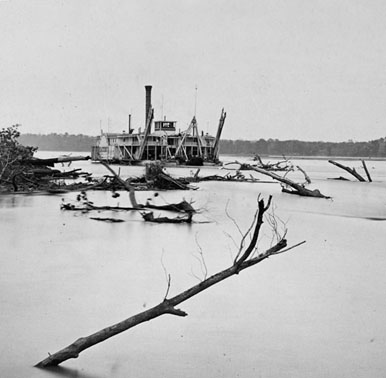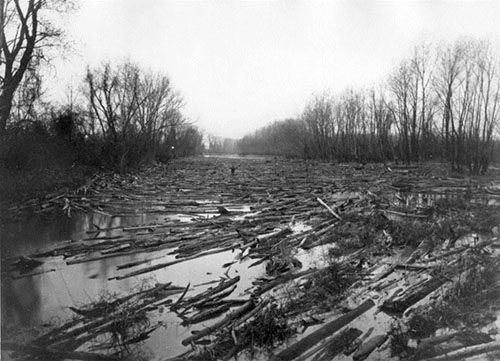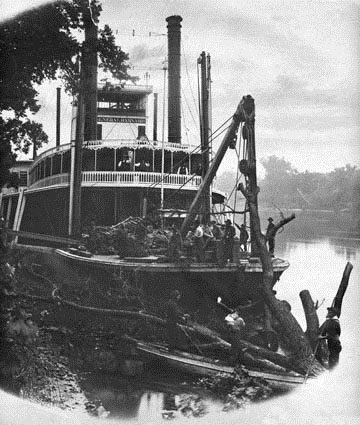 |
| Snagboat J. N. Macomb and river snags |
In America’s steamboat era, the main danger to waterborne travel and commerce was neither fire nor explosions, but rather snags—trees that had fallen into the rivers as a result of bank erosion. The current carried them to the center of the stream, and the heavier end, that with the roots, became lodged in the riverbed with the other end pointed downstream at an angle. A snag could punch a hole in a boat’s hull, often causing it to sink. Particularly dangerous were the fallen trees that lay hidden beneath the river’s surface. Snags caused enormous losses of vessels, cargoes, and lives.
During an age when America moved mostly by water, the U.S. Army Corps of Engineers began removing snags and other obstructions on navigable rivers in 1824. The first truly practicable snagboat was conceived by veteran riverman Henry Miller Shreve. Christened the Heliopolis, it was a twin-hulled craft with an iron-sheathed beam, called a butting beam, connecting the hulls. To remove a snag, the vessel rammed it with the butting beam, dislodging the snag and allowing the crew to lift it onto the boat with a windlass. There it was cut up, the pieces to be used as fuel or thrown into the water to float harmlessly downstream.
The secretary of war appointed Shreve as the Corps of Engineers’ superintendent of western river improvements. Between 1828 and 1841 Shreve’s later boats removed snags on the Mississippi, Ohio, Arkansas, Cumberland, and other major rivers and their tributaries. His greatest achievement was the partial clearing of the Red River Raft, a 150-mile logjam that had for years made the Red virtually unnavigable.
 |
Although Shreve successfully cleared most of the raft from the Red River,
the accumulation of snags on the waterway was a recurring problem.
In 1873 the river was nearly completely blocked by a raft of snags. |
Throughout the nineteenth century and well into the twentieth, the Corps of Engineers operated many snagboats (called “Uncle Sam’s toothpullers”) on the nation’s waterways. Although the vessels followed Shreve’s basic design, they became larger and more sophisticated, using chains, windlasses, and capstans to hoist the snags on board ship. To prevent trees from becoming obstructions in the rivers, crews often went ashore to cut down those about to fall.
 |
| Snagboat Gen. Barnard at work, late 1800s |
A typical snagboat was the Missouri (originally the C. R. Suter), a steel-hulled sidewheeler built in 1888 and operated by the Corps’ Missouri River Commission and later its Kansas City District. It performed its duties primarily on the lower Missouri River, where the problem of snags was particularly acute. In what was probably a representative year, 1916, the Missouri’s crew removed 2,109 obstructions (which included boulders and wrecked vessels as well as snags) and felled 1,959 trees. The career of the long-serving vessel came to an end in 1928 when it was destroyed by fire. By that time there was less need for snagging operations. Bank stabilization and the straightening of river channels had done much to eliminate the problem. The Corps of Engineers’ once large fleet of snagboats has dwindled to virtually nothing. Today, draglines remove most of the occasional snags.
Now largely forgotten, snagboats played a major role in allowing the movement of people and goods in the nineteenth and early twentieth centuries. They facilitated the expansion of commerce and the development of the nation’s frontier regions and saved millions of dollars by preventing loses of vessels and cargoes.
To see a large collection of images of historical USACE floating plant, including snagboats, see the floating plant collection on the USACE Digital Library.
* * *
September 2009. No. 120.